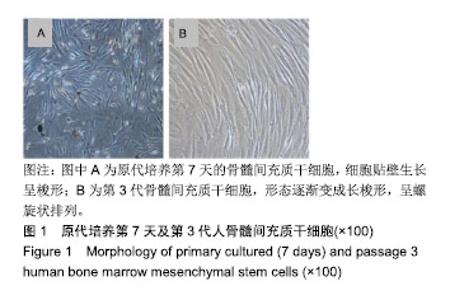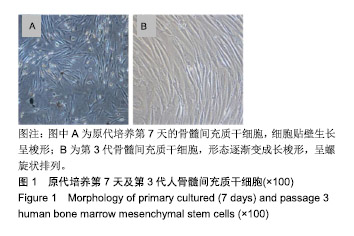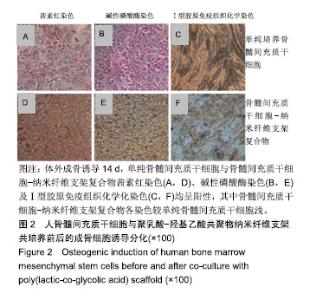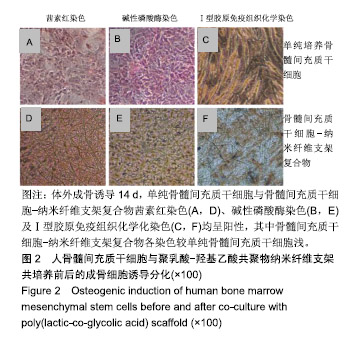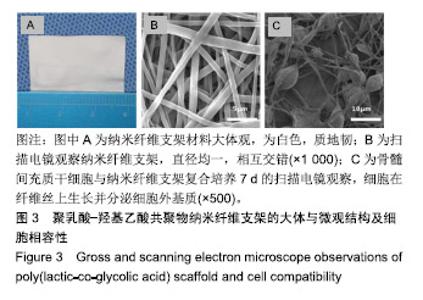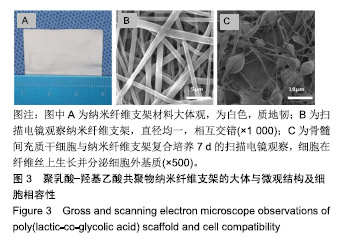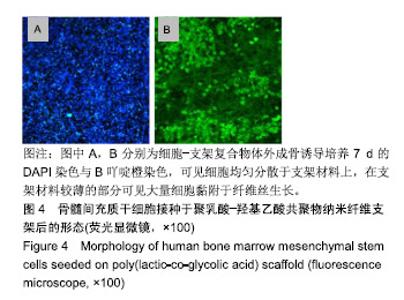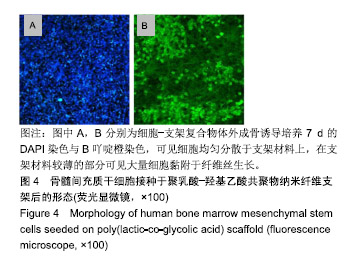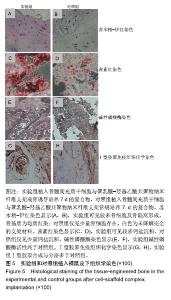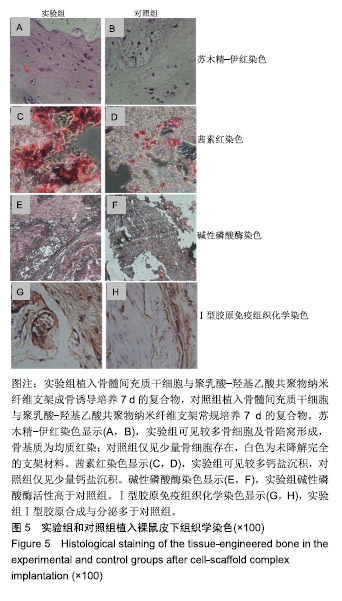Chinese Journal of Tissue Engineering Research ›› 2019, Vol. 23 ›› Issue (26): 4109-4114.doi: 10.3969/j.issn.2095-4344.1347
Previous Articles Next Articles
Construction of tissue engineered bone by poly(lactic-co-glycolic acid) scaffold carrying human bone marrow mesenchymal stem cells
-
Received:2019-04-22Online:2019-09-18Published:2021-04-29 -
Contact:Ma Minxian, Chief physician, Guizhou Medical University, Guiyang 550004, Guizhou Province, China; Department of Prosthodontics, Stomatological Hospital of Guizhou Medical University, Guiyang 550004, Guizhou Province, China; National-Guizhou Joint Engineering Laboratory of Cell Engineering and Biomedicine Technique, Guiyang 550004, Guizhou Province, China; Research Center of Tissue Engineering and Stem Cell Technique, Guizhou Medical University, Guiyang 550004, Guizhou -
About author:Chen Jiao, Master candidate, Physician, Guizhou Medical University, Guiyang 550004, Guizhou Province, China; Department of Prosthodontics, Stomatological Hospital of Guizhou Medical University, Guiyang 550004, Guizhou Province, China; National-Guizhou Joint Engineering Laboratory of Cell Engineering and Biomedicine Technique, Guiyang 550004, Guizhou Province, China -
Supported by:the National Natural Science Foundation of China, No. 81360232 (to YC); the Science and Technology Planning Project of Guiyang, No. [2018]1-81 (to MMX)
CLC Number:
Cite this article
Chen Jiao, Shu Liping, Li Xuanze, Liu Qin, Wu Ying, Liu Yin, Wang Weiyu, Liu Jun, Ye Chuan, Ma Minxian. Construction of tissue engineered bone by poly(lactic-co-glycolic acid) scaffold carrying human bone marrow mesenchymal stem cells[J]. Chinese Journal of Tissue Engineering Research, 2019, 23(26): 4109-4114.
share this article
| [1]韦应明,雷利红,陈莉丽.骨组织工程支架与生长因子结合方法研究进展[J].中国实用口腔科杂志,2018,11(6):374-378.[2]Turnbull G,Clarke J,Picard F,et al.3D bioactive composite scaffolds for bone tissue engineering.Bioact Mater. 2017;3(3):278-314.[3]Wu T,Yu S,Chen D,et al.Bionic Design, Materials and Performance of Bone Tissue Scaffolds. Materials. 2017;10(10):1187.[4]Henkel J,Woodruff MA,Epari DR,et al.Bone Regeneration Based on Tissue Engineering Conceptions -A 21st Century Perspective.Bone Resh.2013;1(3):216-248.[5]Gu M,Liu Y,Chen T,et al.Is Graphene a Promising Nano-Material for Promoting Surface Modification of Implants or Scaffold Materials in Bone Tissue Engineering.Tissue Eng Part B Rev.2014;20(5): 477-491.[6]Yu H, Adesida AB,Jomha NM.Meniscus repair using mesenchymal stem cells – a comprehensive review. Stem Cell Res Ther.2015; 6(1):86.[7]Potier E,Noailly J,Ito K.Directing bone marrow-derived stromal cell function with mechanics. J Biomech. 2010;43(5):807-817.[8]Ge M,Ge K,Gao F,et al.Biomimetic mineralized strontium-doped hydroxyapatite on porous poly(L-lactic acid) scaffolds for bone defect repair.Int J Nanomedicine. 2018;13:1707-1721.[9]杨文峰,任远飞,梁武,等.PLGA电纺丝对大鼠骨髓间充质干细胞成骨分化的影响[J].现代医学,2017,45(5):623-627.[10]Yang X,Li Y,Liu X,et al. Incorporation of silica nanoparticles to PLGA electrospun fibers for osteogenic differentiation of human osteoblast-like cells.Regen Biomater. 2018;5(4):229-238.[11]Guimarães P,Oliveira S,Castro Rodrigues G,et al. Development of Sulfadiazine-Decorated PLGA Nanoparticles Loaded with 5-Fluorouracil and Cell Viability.Molecules.2015;20(1):879-899.[12]Jun I, Han HS, Edwards JR,et al.Electrospun Fibrous Scaffolds for Tissue Engineering: Viewpoints on Architecture and Fabrication.Int J Mol Sci.2018;19(3):745.[13]Sankar S,Sharma CS,Rath SN.Enhanced osteodifferentiation of MSC spheroids on patterned electrospun fiber mats - An advanced 3D double strategy for bone tissue regeneration.Mater Sci Eng C Mater Biol Appl. 2019;94:703-712.[14]Yang X,Li Y,He W,et al. Hydroxyapatite/collagen coating on PLGA electrospun fibers for osteogenic differentiation of bone marrow mesenchymal stem cells. J Biomed Mater Res A. 2018;106(11): 2863-2870.[15]Perez JR,Dimitrios K,Li DJ,et al.Tissue Engineering and Cell-Based Therapies for Fractures and Bone Defects.Front Bioeng Biotechnol. 2018;6:105.[16]O'Brien FJ.Biomaterials & scaffolds for tissue engineering. Mater Today. 2011;14(3):88-95.[17]Roseti L,Parisi V,Petretta M,et al.Scaffolds for Bone Tissue Engineering: State of the art and new perspectives.Mater Sci Eng C Mater Biol Appl. 2017;78:1246.[18]Valencia C,Valencia C,Zuluaga F,et al.Synthesis and Application of Scaffolds of Chitosan-Graphene Oxide by the Freeze-Drying Method for Tissue Regeneration. Molecules. 2018;23(10):2651.[19]Shichao Z,Malcolm X,Bingyun L.Biomimetic Layer-by-Layer Self-Assembly of Nanofilms, Nanocoatings and 3D Scaffolds for Tissue Engineering.Int J Mol Sci. 2018;19(6):1641.[20]Du MH,Ding Y,Shi X,et al.The Periosteal Autografts Transplantation for Cartilage Defects of the Hip in Older Children With Developmental Dysplasia as an Adjunctive Procedure.Medicine. 2016;95(17):e3432.[21]Hoffman MD,Xie C,Zhang X,et al.The effect of mesenchymal stem cells delivered via hydrogel-based tissue engineered periosteum on bone allograft healing. Biomaterials. 2013; 34(35):8887-8898.[22]Deval B,Ludwig A,Chan P,et al.A Review on Properties of Natural and Synthetic Based Electrospun Fibrous Materials for Bone Tissue Engineering.Membranes.2018;8(3):62.[23]Gentile P,Chiono V,Carmagnola L,et al.An Overview of Poly(lactic-co-glycolic) Acid (PLGA)-Based Biomaterials for Bone Tissue Engineering.Int J Mol Sci. 2014;15(3):3640-3659.[24]Fu C,Bai H,Zhu J,et al.Enhanced cell proliferation and osteogenic differentiation in electrospun PLGA/hydroxyapatite nanofibre scaffolds incorporated with graphene oxide.PLoS One. 2017; 12(11):e0188352.[25]Kwak S,Haider A,Gupta KC,et al.Micro/Nano Multilayered Scaffolds of PLGA and Collagen by Alternately Electrospinning for Bone Tissue Engineering.Nanoscale Res Lett. 2016;11(1):323. [26]Park BH,Zhou L,Jang KY, et al.Enhancement of tibial regeneration in a rat model by adipose-derived stromal cells in a PLGA scaffold. Bone. 2012;51(3):313-323.[27]Chiesa E,Pisani S,Colzani B,et al.Intra-Articular Formulation of GE11-PLGA Conjugate-Based NPs for Dexamethasone Selective Targeting—In Vitro Evaluation.Int J Mol Sci. 2018;19(8):2304.[28]Mir M,Ali MN,Barakullah A,et al.Synthetic polymeric biomaterials for wound healing: a review. Prog Biomater. 2018;7(1):1-21.[29]Wu J,Hong Y.Enhancing cell infiltration of electrospun fibrous scaffolds in tissue regeneration.Bioact Mater. 2016;1(1):56-64.[30]Wang W,Nie W,Liu D,et al.Macroporous nanofibrous vascular scaffold with improved biodegradability and smooth muscle cells infiltration prepared by dual phase separation technique. Int J Nanomedicine.2018;13:7003-7018.[31]Sascha Z,Toby B,Johannes R,et al.Poly(ε-caprolactone) Scaffolds Fabricated by Melt Electrospinning for Bone Tissue Engineering. Materials.2016;9(4):232.[32]Tibbitt MW,Anseth KS.Hydrogels as extracellular matrix mimics for 3D cell culture. Biotechnol Bioeng. 2010;103(4):655-663.[33]Ma MX,Liu Q,Ye C,et al.Preparation of P3HB4HB/(Gelatin + PVA) Composite Scaffolds by Coaxial Electrospinning and Its Biocompatibility Evaluation.Biomed Res Int. 2017;2017:9251806. [34]Julia S, Moritz P, Alexandra D, et al. Journey into Bone Models: A Review. Genes.2018;9(5):247.[35]Shao W,He J, Sang F,et al.Coaxial electrospun aligned tussah silk fibroin nanostructured fiber scaffolds embedded with hydroxyapatite–tussah silk fibroin nanoparticles for bone tissue engineering. Mater Sci Eng C Mater Biol Appl. 2016;58:342-351. |
| [1] | Zhang Tongtong, Wang Zhonghua, Wen Jie, Song Yuxin, Liu Lin. Application of three-dimensional printing model in surgical resection and reconstruction of cervical tumor [J]. Chinese Journal of Tissue Engineering Research, 2021, 25(9): 1335-1339. |
| [2] | Zou Gang, Xu Zhi, Liu Ziming, Li Yuwan, Yang Jibin, Jin Ying, Zhang Jun, Ge Zhen, Liu Yi. Human acellular amniotic membrane scaffold promotes ligament differentiation of human amniotic mesenchymal stem cells modified by Scleraxis in vitro [J]. Chinese Journal of Tissue Engineering Research, 2021, 25(7): 1037-1044. |
| [3] | Zeng Yanhua, Hao Yanlei. In vitro culture and purification of Schwann cells: a systematic review [J]. Chinese Journal of Tissue Engineering Research, 2021, 25(7): 1135-1141. |
| [4] | Xu Dongzi, Zhang Ting, Ouyang Zhaolian. The global competitive situation of cardiac tissue engineering based on patent analysis [J]. Chinese Journal of Tissue Engineering Research, 2021, 25(5): 807-812. |
| [5] | Li Wenjing, Li Haobo, Liu Congna, Cheng Dongmei, Chen Huizhen, Zhang Zhiyong. Comparison of different bioactive scaffolds in the treatment of regenerative pulp of young permanent teeth [J]. Chinese Journal of Tissue Engineering Research, 2021, 25(4): 499-503. |
| [6] | Zhou Jihui, Yao Meng, Wang Yansong, Li Xinzhi, Zhou You, Huang Wei, Chen Wenyao. Influence of novel nanoscaffolds on biological behaviors of neural stem cells and the related gene expression [J]. Chinese Journal of Tissue Engineering Research, 2021, 25(4): 532-536. |
| [7] | Ma Zhijie, Li Jingyu, Cao Fang, Liu Rong, Zhao Dewei. Influencing factors and biological property of novel biomedical materials: porous silicon carbide coated with bioactive tantalum [J]. Chinese Journal of Tissue Engineering Research, 2021, 25(4): 558-563. |
| [8] | Wu Zijian, Hu Zhaoduan, Xie Youqiong, Wang Feng, Li Jia, Li Bocun, Cai Guowei, Peng Rui. Three-dimensional printing technology and bone tissue engineering research: literature metrology and visual analysis of research hotspots [J]. Chinese Journal of Tissue Engineering Research, 2021, 25(4): 564-569. |
| [9] | Chang Wenliao, Zhao Jie, Sun Xiaoliang, Wang Kun, Wu Guofeng, Zhou Jian, Li Shuxiang, Sun Han. Material selection, theoretical design and biomimetic function of artificial periosteum [J]. Chinese Journal of Tissue Engineering Research, 2021, 25(4): 600-606. |
| [10] | Liu Liu, Zhou Qingzhu, Gong Zhuo, Liu Boyan, Yang Bin, Zhao Xian. Characteristics and manufacturing techniques of collagen/inorganic materials for constructing tissue-engineered bone [J]. Chinese Journal of Tissue Engineering Research, 2021, 25(4): 607-613. |
| [11] | Liu Fei, Cui Yutao, Liu He. Advantages and problems of local antibiotic delivery system in the treatment of osteomyelitis [J]. Chinese Journal of Tissue Engineering Research, 2021, 25(4): 614-620. |
| [12] | Ye Haimin, Ding Linghua, Kong Weihao, Huang Zutai, Xiong Long. Role and mechanism of hierarchical microchanneled bone scaffolds in promoting osteogenesis and angiogenesis [J]. Chinese Journal of Tissue Engineering Research, 2021, 25(4): 621-625. |
| [13] | Li Xiaozhuang, Duan Hao, Wang Weizhou, Tang Zhihong, Wang Yanghao, He Fei. Application of bone tissue engineering materials in the treatment of bone defect diseases in vivo [J]. Chinese Journal of Tissue Engineering Research, 2021, 25(4): 626-631. |
| [14] | Zhang Zhenkun, Li Zhe, Li Ya, Wang Yingying, Wang Yaping, Zhou Xinkui, Ma Shanshan, Guan Fangxia. Application of alginate based hydrogels/dressings in wound healing: sustained, dynamic and sequential release [J]. Chinese Journal of Tissue Engineering Research, 2021, 25(4): 638-643. |
| [15] | Chen Jiana, Qiu Yanling, Nie Minhai, Liu Xuqian. Tissue engineering scaffolds in repairing oral and maxillofacial soft tissue defects [J]. Chinese Journal of Tissue Engineering Research, 2021, 25(4): 644-650. |
| Viewed | ||||||
|
Full text |
|
|||||
|
Abstract |
|
|||||
